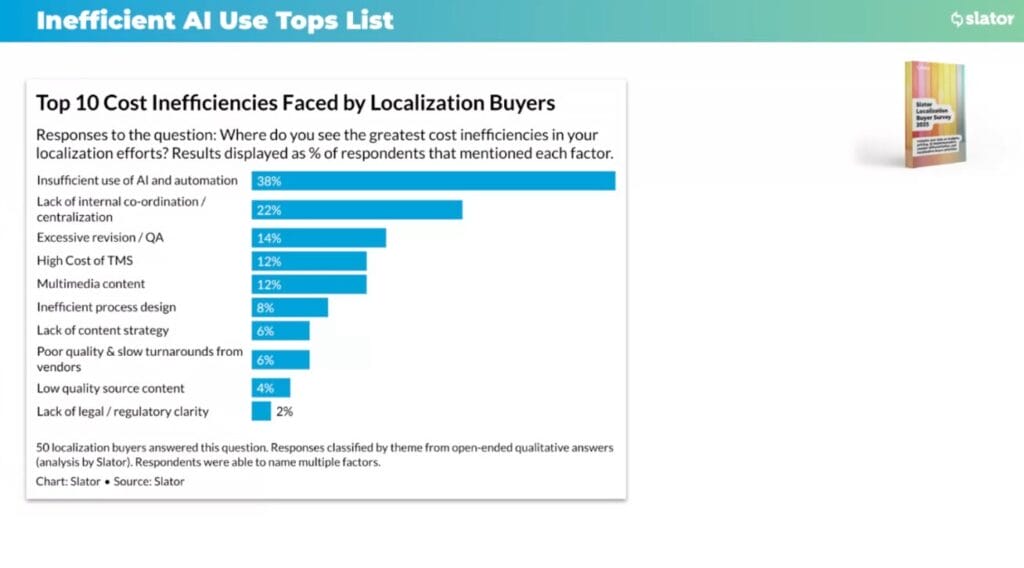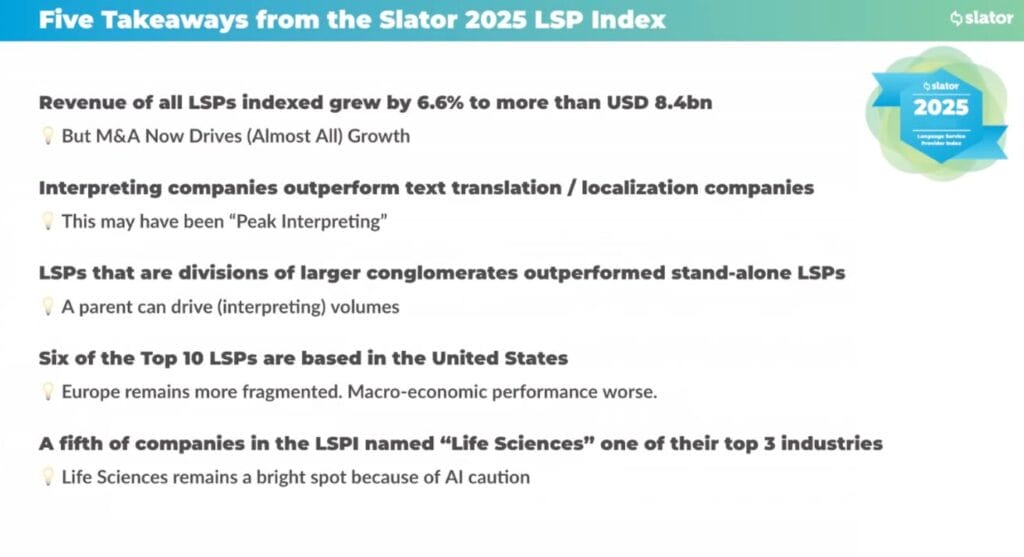AI isn’t the story anymore. It’s the setting. At SlatorCon Remote March 2025, the real conversation was about what happens after adoption: the messy, strategic, and often uneven reality of integrating AI into localization at scale. Yes, the technology is powerful. But the real transformation is unfolding in how companies are, or aren’t, restructuring around it.
Localization is no longer a side project tucked under marketing or product. It is becoming a revenue engine, a quality battleground, and a proving ground for multilingual-first content strategies. And while some businesses are adapting fast, others are discovering that simply plugging AI into legacy workflows won’t cut it.
Here are five takeaways from this year’s event that show where the industry is headed, and where it’s hitting resistance.
1. Everyone loves AI—but most companies aren’t great at using it
AI has become a fixture in localization conversations for good reason. It promises faster turnaround times, lower costs, and scalable multilingual content. But there’s a growing gap between expectation and execution.
Despite widespread investment, many companies are still struggling to make AI deliver real value.
According to information shared by Florian Faes, Managing Director of Slator, 38% of localization buyers said inefficient AI use is their biggest cost inefficiency. That puts it far ahead of other issues like poor internal coordination or excessive revision cycles, which came in at just 10 to 15 percent.

“There’s probably a certain FOMO factor. Like, you see all these cool new technologies out there, but I’m not really using much here.”
— Florian Faes, Managing Director, Slator
The issue isn’t that the tech doesn’t work. It’s that companies often implement AI without the right foundations. Some adopt advanced platforms but skip the training and governance needed to make them effective. Others bolt AI onto outdated workflows, hoping for transformation without the legwork.
It’s becoming clear that AI only works if the organization is ready for it. This makes AI adoption a digital transformation issue.
While it can offer quick wins, it needs to be treated as a long-term investment. There’s a need to build the internal capability to manage it, and align it with clear business goals. The most successful companies are those combining automation with human oversight and deep process integration.
“If you want to tap into that customization, you do need to go through your own data. That data source—the golden source of truth—is the translation memory.”
— Simone Bohnenberger-Rich, Turning GenAI into ROI
2. Content adaptation and transcreation are turning localization into a revenue engine
AI isn’t just helping companies translate faster. It’s enabling a shift from translation to content adaptation and transcreation—two areas now central to driving revenue, not just managing cost. At SlatorCon, this shift stood out as one of the most commercially significant uses of AI in localization today.
Content adaptation and transcreation go beyond linguistic accuracy. They reshape tone, style, and messaging to match cultural context and emotional nuance. This approach is helping businesses move from one-size-fits-all content to something far more personal and persuasive.
“One of the most promising use cases we see that really moves localization teams more into that pole position of revenue generation is really around adaptation and transcreation. We at Phrase sometimes call it hyper-personalization.”
— Simone Bohnenberger-Rich, Chief Product Officer, Phrase

Imagine launching a campaign that automatically adapts its messaging for dozens of markets at once, or updating an ecommerce product description to align with local values and preferences—without manual rework. These scenarios are already playing out inside global SaaS and retail businesses using AI to localize in real time.
Done right, this kind of intelligent adaptation delivers measurable business outcomes. Companies are seeing stronger engagement, faster go-to-market timelines, and better conversion rates. For localization teams, it’s a clear opportunity to move from the back office into a central role in business growth.
3. Growth is happening, but it’s coming from consolidation—not new business
The language industry is expanding, but not in the way most might expect. Despite all the buzz around AI and innovation, organic growth remains limited. Instead, most of the recent gains have come from mergers and acquisitions, not from a surge in customer demand.
According to Slator’s LSP Provider Index, the total revenue of all indexed language service providers grew by 6.6 percent to over 8.4 billion dollars. But much of that growth was tied to consolidation efforts, not to a broader expansion of the market.

“We cover a big chunk of the industry with over $8 billion in revenue. But most of that growth actually is derived from M&A. There hasn’t been much organic growth across the industry.”
— Florian Faes, Managing Director, Slator
This trend has serious implications for smaller, independent providers. As larger players continue to merge and scale, the competitive gap widens. Independent firms without the same access to capital or technology may find it harder to stay relevant.
One exception to the slowdown in organic growth has been interpreting services, particularly in the US healthcare market. Demand has remained strong, though some believe 2024 may have marked the peak for interpreting in that sector.
4. Quality control is getting smarter, but it still needs a human touch
AI is making real progress in quality control. From detecting inconsistent terminology to flagging off-brand language, automated systems are helping teams deliver more polished content at scale. But even the most advanced tools have their limits.
“AI agents will add a layer of quality control that increases efficiency without compromising standards.”
What AI does exceptionally well is speed. It can catch surface-level issues and reduce the time needed for manual review, sometimes by as much as 70 percent. But it still struggles with the finer points of communication—things like tone, cultural context, and creative alignment.
That’s why the most effective strategies are built around collaboration between humans and AI. With tools like Phrase Quality Performance Score (QPS) and intelligent routing, some companies are already optimizing the handoff. AI handles the high-volume checks, while human reviewers focus on content that demands deeper judgment and nuance.
“We know with Phrase QPS and intelligent routing, some of our customers see a 50 to 70% reduction in human review effort, and that clearly hits the bottom line.”
— Simone Bohnenberger-Rich, Chief Product Officer, Phrase
The takeaway isn’t that AI is replacing people. It’s that it’s finally good enough to support them in a meaningful way. The future of localization lies in this balance. Automation brings efficiency, and human expertise ensures the quality and relevance that global audiences expect.
5. Multilingual-first content is reshaping global strategy
The long-standing model of English-first content creation is starting to shift. As AI becomes more capable, businesses are rethinking how content is planned and produced. Increasingly, they are embracing multilingual-first strategies, creating content in multiple languages from the outset rather than adapting it after the fact.
“We will start seeing content created in multiple languages at the same time, making global market expansion far more seamless.”
— Matteo Nonne, Localization Program Manager, On
This shift is not only about speed, although reducing time-to-market is a major benefit. It also supports greater consistency and cultural relevance. By designing content that works across languages from the beginning, companies can deliver unified campaigns that resonate in every region.
Multilingual-first workflows help teams streamline production. Instead of building content in one language and then retrofitting it, businesses can now integrate AI to support simultaneous creation across markets. That leads to fewer delays, less rework, and stronger alignment across global teams.
The result is more than just operational efficiency. It represents a smarter and more strategic approach to international growth, one that treats global readiness as a starting point rather than an afterthought.
Conclusion
SlatorCon Remote March 2025 made one thing clear: the localization industry is not simply adopting AI, it is being reshaped by it. But the real story is not about the technology itself. It is about how companies are rethinking their structures, strategies, and skill sets to make AI actually work.
From content adaptation and quality control to multilingual-first creation, AI is enabling a faster, more scalable future. But it is not replacing the need for human expertise. If anything, it is making that expertise more valuable. The most successful teams are not those chasing every new tool. They are the ones combining automation with context, speed with strategy, and innovation with experience.
Localization today is about more than translation. It is about revenue, global alignment, and creating content that connects across cultures. The companies that recognize this—who move beyond implementation and into integration—are the ones that will lead the next phase of global growth
Discover more localization events
Join us at one of our in person events in see first-hand how we’re transforming customer experiences and driving international growth.





